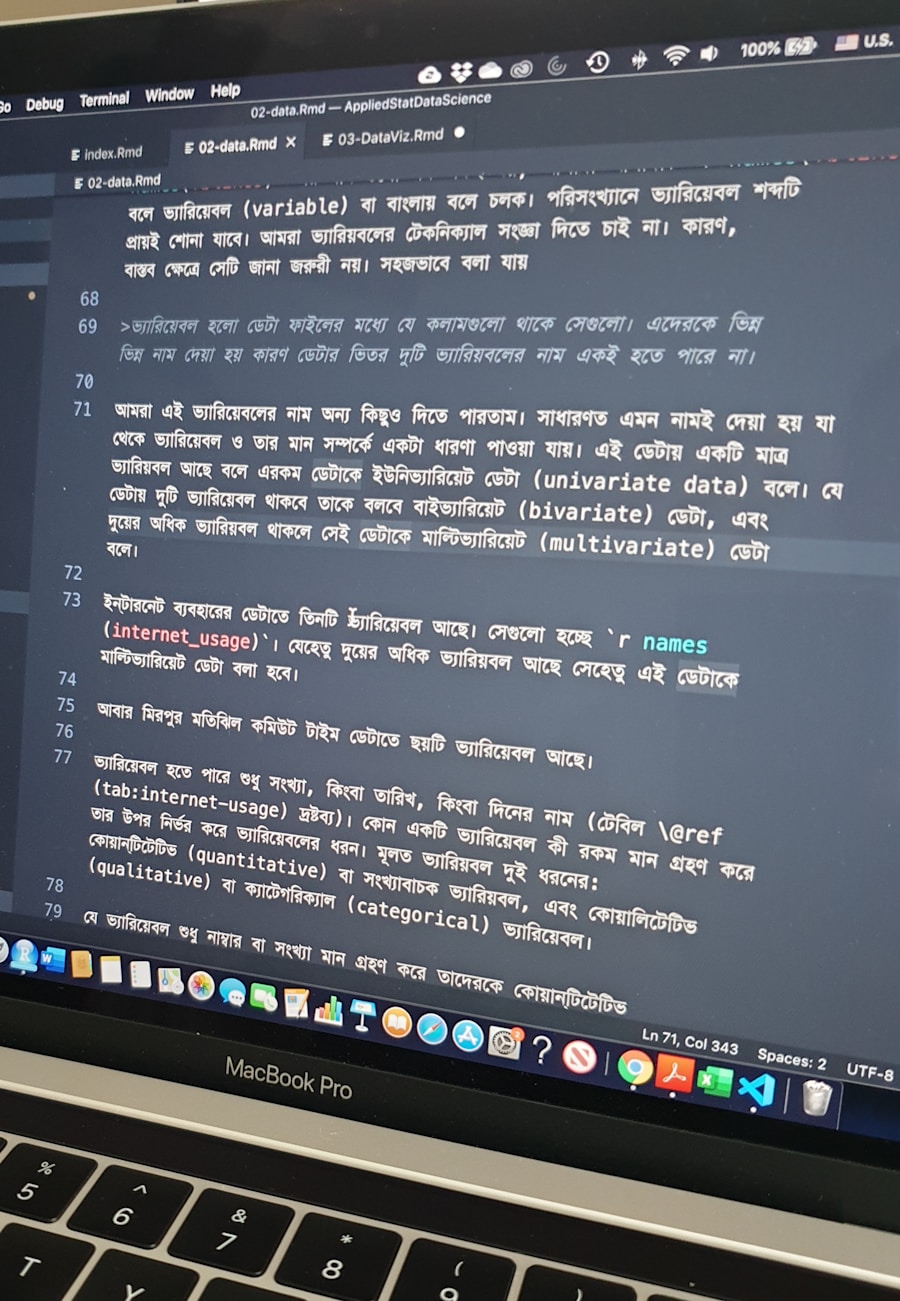Natural Language Processing (NLP) is a subfield of artificial intelligence that focuses on the interaction between computers and human language. It encompasses a range of techniques and methodologies that enable machines to understand, interpret, and generate human language in a way that is both meaningful and contextually relevant. At its core, NLP seeks to bridge the gap between human communication and computer understanding, allowing for more intuitive interactions with technology.
This involves not only the parsing of text but also the comprehension of nuances such as tone, context, and intent. The foundational elements of NLP include syntax, semantics, and pragmatics. Syntax refers to the structure of sentences and the rules that govern the arrangement of words.
Semantics deals with the meaning of words and phrases, while pragmatics focuses on how context influences interpretation. For instance, the sentence “It’s cold in here” could be a simple observation or a subtle request to close a window, depending on the context in which it is spoken. Understanding these layers is crucial for developing effective NLP applications, as they allow machines to process language in a way that mimics human understanding.
Key Takeaways
- NLP is a branch of artificial intelligence that focuses on the interaction between computers and humans through natural language.
- Advanced language processing with NLP involves leveraging techniques such as named entity recognition, part-of-speech tagging, and syntactic parsing for more complex language understanding.
- Text analysis with NLP techniques allows for tasks such as topic modeling, summarization, and entity extraction to be performed on large volumes of text data.
- Sentiment analysis using NLP enables the identification and categorization of opinions expressed in text, providing valuable insights for businesses and organizations.
- NLP can be utilized for language generation through techniques such as machine translation, text summarization, and dialogue generation, as well as for language understanding through tasks like question answering and information retrieval.
Leveraging NLP for Advanced Language Processing
Advanced language processing through NLP involves utilizing sophisticated algorithms and models to analyze and manipulate text data. One of the most significant advancements in this area has been the development of deep learning techniques, particularly neural networks. These models can learn from vast amounts of text data, identifying patterns and relationships that traditional rule-based systems might miss.
For example, recurrent neural networks (RNNs) and transformers have revolutionized how machines process sequences of words, enabling them to generate coherent and contextually appropriate responses. Moreover, NLP can be leveraged for various applications beyond simple text analysis. In customer service, chatbots powered by NLP can engage users in natural conversations, providing assistance and information without human intervention.
These systems can understand user queries, retrieve relevant information from databases, and respond in a conversational manner. This not only enhances user experience but also reduces operational costs for businesses. The ability to process language at an advanced level allows organizations to automate tasks that were previously time-consuming and labor-intensive.
Exploring NLP Techniques for Text Analysis

Text analysis is a critical component of NLP that involves extracting meaningful information from unstructured text data. Various techniques are employed to achieve this, including tokenization, part-of-speech tagging, named entity recognition (NER), and topic modeling. Tokenization is the process of breaking down text into smaller units, such as words or phrases, which can then be analyzed individually.
This step is essential for preparing text data for further processing. Part-of-speech tagging assigns grammatical categories to each word in a sentence, helping to clarify their roles within the context. For instance, in the sentence “The cat sat on the mat,” tagging would identify “cat” as a noun and “sat” as a verb.
Named entity recognition goes a step further by identifying specific entities within the text, such as names of people, organizations, or locations. This technique is particularly useful in applications like information retrieval and knowledge extraction, where understanding the context of entities is crucial for accurate results. Topic modeling is another powerful technique used in text analysis to uncover hidden themes within large datasets.
Algorithms like Latent Dirichlet Allocation (LDA) can analyze documents to identify clusters of words that frequently occur together, thereby revealing underlying topics. This method is invaluable for businesses looking to analyze customer feedback or social media conversations, as it allows them to gauge public sentiment on various issues or products.
Harnessing the Power of NLP for Sentiment Analysis
| Data Source | Metrics | Results |
|---|---|---|
| Positive Sentiment | 65% | |
| Negative Sentiment | 20% | |
| Neutral Sentiment | 15% | |
| Customer Reviews | Positive Sentiment | 75% |
| Customer Reviews | Negative Sentiment | 10% |
| Customer Reviews | Neutral Sentiment | 15% |
Sentiment analysis is a specialized application of NLP that focuses on determining the emotional tone behind a body of text. This technique has gained immense popularity in recent years due to its ability to provide insights into public opinion and consumer behavior. By analyzing social media posts, product reviews, or customer feedback, businesses can gauge how their audience feels about their brand or specific offerings.
The process typically involves classifying text as positive, negative, or neutral based on the sentiment expressed. Machine learning models trained on labeled datasets can effectively identify sentiment by recognizing patterns in word usage and context. For example, phrases like “I love this product” would be classified as positive sentiment, while “I hate waiting for delivery” would indicate negative sentiment.
Advanced models can even detect nuances such as sarcasm or mixed emotions, which are often challenging for simpler algorithms. Sentiment analysis has practical applications across various industries. In marketing, companies can monitor brand sentiment in real-time to adjust their strategies accordingly.
In politics, sentiment analysis can provide insights into public opinion on policies or candidates by analyzing social media discussions. The ability to quantify sentiment allows organizations to make data-driven decisions that align with consumer preferences and expectations.
Utilizing NLP for Language Generation and Understanding
Language generation is another fascinating aspect of NLP that involves creating coherent and contextually relevant text based on input data. This capability has been significantly enhanced by advancements in deep learning models such as OpenAI’s GPT series and Google’s BERT. These models are trained on vast corpora of text data and can generate human-like responses to prompts, making them suitable for applications ranging from content creation to automated customer support.
For instance, businesses can utilize language generation models to create personalized marketing messages or product descriptions tailored to specific audiences. By inputting key information about a product or service, these models can generate engaging content that resonates with potential customers. Additionally, language generation can be employed in creative writing applications, where authors can receive suggestions or even entire paragraphs based on their writing style and themes.
Understanding language is equally important in NLP applications. Contextual understanding allows machines to interpret user queries accurately and provide relevant responses. For example, virtual assistants like Siri or Alexa rely on NLP techniques to comprehend spoken commands and execute tasks accordingly.
The ability to understand natural language not only enhances user experience but also opens up new possibilities for human-computer interaction.
Integrating NLP with Machine Learning for Enhanced Language Processing

The integration of NLP with machine learning has transformed how we approach language processing tasks. Machine learning algorithms enable systems to learn from data rather than relying solely on predefined rules. This shift has led to more robust and adaptable NLP applications capable of handling diverse linguistic challenges.
Supervised learning techniques are commonly used in NLP tasks such as classification and regression. For instance, training a model to classify emails as spam or not spam involves feeding it labeled examples so it can learn distinguishing features. Unsupervised learning methods like clustering are also valuable for discovering patterns in unlabeled data, such as grouping similar documents based on content.
Deep learning architectures have further advanced this integration by allowing models to learn hierarchical representations of language data. Convolutional neural networks (CNNs) are often employed for tasks like text classification, while RNNs excel at sequence prediction tasks such as language translation or speech recognition. The combination of these techniques enables more accurate predictions and better performance across various NLP applications.
Overcoming Challenges in NLP for Advanced Language Processing
Despite its advancements, NLP faces several challenges that researchers and practitioners must address to improve its effectiveness further. One significant challenge is dealing with ambiguity in language. Words can have multiple meanings depending on context; for example, “bank” could refer to a financial institution or the side of a river.
Disambiguating such terms requires sophisticated algorithms capable of understanding context at a deeper level. Another challenge lies in handling diverse languages and dialects. While many NLP models perform well in English due to the abundance of training data available, they may struggle with less commonly spoken languages or regional dialects that lack sufficient resources.
Developing multilingual models that can understand and generate text across various languages remains an ongoing area of research. Additionally, ethical considerations surrounding bias in NLP models must be addressed. If training data contains biases—whether related to gender, race, or socioeconomic status—these biases can be perpetuated in model predictions.
Ensuring fairness and inclusivity in NLP applications requires careful curation of training datasets and ongoing monitoring of model outputs.
Future Trends and Developments in NLP for Language Processing
The future of NLP holds exciting possibilities as technology continues to evolve rapidly. One emerging trend is the development of more sophisticated conversational agents capable of engaging users in natural dialogues over extended interactions. These agents will leverage advancements in contextual understanding and memory retention to provide personalized experiences tailored to individual users’ preferences.
Another area poised for growth is the integration of multimodal inputs into NLP systems. By combining text with other forms of data—such as images or audio—models can gain richer contextual insights that enhance their understanding and generation capabilities. For instance, an AI system could analyze a video clip alongside its transcript to provide more accurate sentiment analysis based on visual cues.
Furthermore, advancements in explainable AI (XAI) will play a crucial role in making NLP systems more transparent and interpretable. As organizations increasingly rely on AI-driven decisions, understanding how models arrive at their conclusions becomes essential for building trust among users. In summary, the landscape of Natural Language Processing is continually evolving, driven by technological advancements and an increasing demand for more intuitive human-computer interactions.
As researchers tackle existing challenges and explore new frontiers, we can expect NLP to become an even more integral part of our daily lives.












Leave a Reply